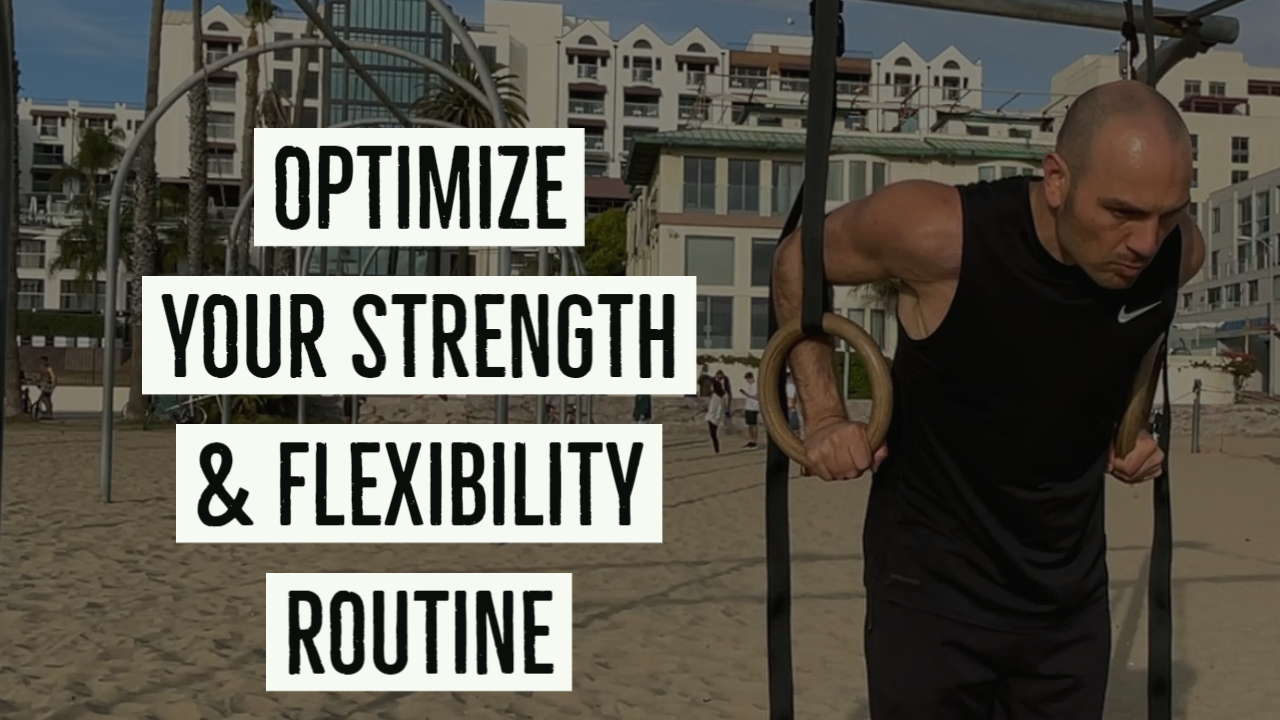
In this blog post I’m going to share with you all the ways in which all the ways in which flexibility training and strength training are both similar and different so you can have a better idea on how to structure your workouts. We will also go over the importance of balancing between frequency, intensity and volume and figure out what is the best version for you!

- Examples of compound exercises:
- Bodyweight: Pushups, pullups, rows, dips, handstand pushups, squats.
- Weightlifting: Barbell squats, deadlifts, bench press, overhead press.
- Examples of isolation exercises:
- Bicep curls, tricep extensions, delt raises, leg extensions/curls, hip thrusts and calf raises.
You don’t want to initially exhaust the individual muscles that are going to be needed for compound exercises. For example, it would be a bad idea to do sets of bicep curls before doing pullups. Because then your pullups would start to fail because your biceps are giving out and not your lats. It would similarly be a bad idea to hang until failure, exhausting your forearms and grip strength before doing pullups because your grip strength will fail before you can do all your pullups properly.
The other way around works perfectly: Work on the compound exercises first and finish off with isolation exercises. This will allow you to get far more volume (sets and reps) and allow you to efficiently build strength and gain hypertrophy (muscle mass). This is why in my false-grip tutorial video I recommend you end your workouts with the false-grip since you won’t need your grip for anything else at that point.
A few of the major poses for flexibility are the front splits, straddle splits and bridge pose. The expression of these poses require flexibility of multiple major muscle groups simultaneously and your range will be limited by whatever individual muscle is tightest, so working on the individual muscles first is crucial to remove those limiting factors as much as possible before moving to the grand-daddy stretch.
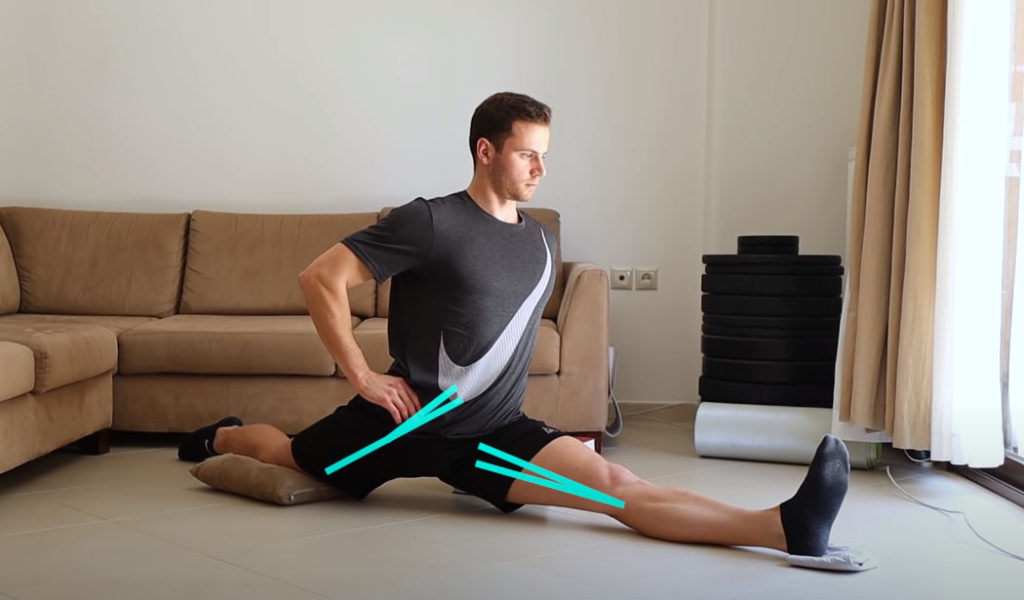
- For the Front Splits: Stretch your hamstrings and hip flexors before working on front splits.
- For the Bridge: Stretch your lats and hip flexors and work on thoracic extension individually before working on the final bridge.
- For the Middle Splits: Stretch your adductors individually before working on the straddle.
Going from “small” to “big” is the proper way to structure a stretching session. Doing it the other way would be extremely inefficient and possibly downright dangerous.
More Examples:
- Going into a bridge (full-wheel pose) when you haven’t stretched your hip flexors is going to cause your lower back to arch far more than it should.
- Going into the middle splits when you haven’t individually stretched and strengthened the adductors is a bad idea. Instead in my follow along video, we go from frog-pose to one-leg frog pose to open up the adductors, then hold the horse-stance to strengthen them. Only after such a session is it a good idea to test your middle splits!
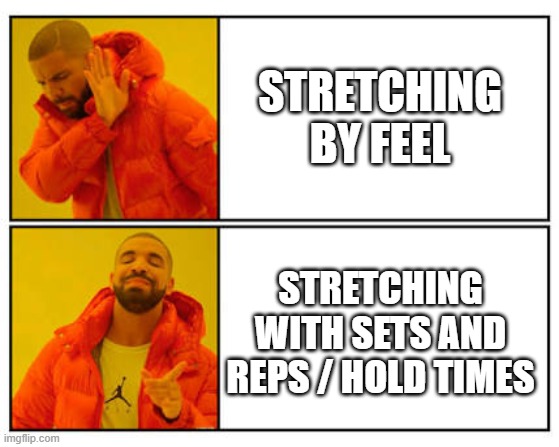
Flexibility training, when done right, is just like strength training except its focus is on the end-range of motion. Why do people workout methodically when it comes to strength training (being very meticulous with logging their sets and reps) but when it comes to flexibility they hold a stretch for however long they “feel” is “enough” rather than using a timer to make sure they’re doing it for a significant amount of time?
- The same way you strength train by doing 3-5 sets, resting between sets, is the same way you should stretch.
- Holding a stretch for 3 minutes nonstop is not as effective breaking it up into 3 sets of 1 minute holds. The body benefits from resting in between sets to recover and give you the best results, just like when strength training.
- Volume = Total amount of work (sets+reps).
- Intensity = Amount of weight/load.
- Frequency = How many times a week you train a muscle group.

- Want to train 5-6 days a week? High frequency equates to few rest days which means you must purposely limit how hard you train (low to medium volume and/or intensity) on any workout session so the body doesn’t have as much to recover from. (Meaning, do not go to absolute failure, leave some gas in the tank and end the session while you’re still ahead!)
- Want to train only 2 days a week? Low frequency means you’re going to have to train very hard (medium to high volume and/or intensity) to make up for the fact that you only have 2 opportunities a week to gain strength or mobility but in return, have many rest days to recover.
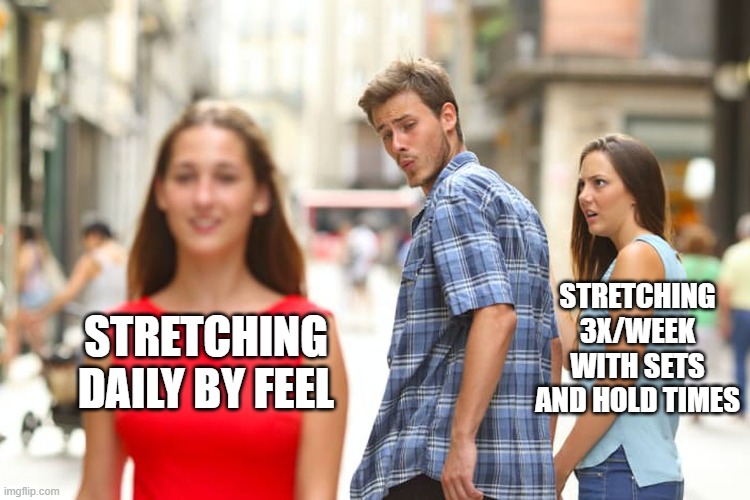
How many times have you read that if you want to get flexible, you need to stretch every day? Why don’t people say “If you want to get strong, you must lift every single day?” Because the accumulated fatigue would destroy your performance and eventually lead to injury. (Unless, like mentioned before, you are purposely limiting your volume and intensity because you know you’re going to workout the next day as well.) So, the same way you don’t have to strength-train everyday to make progress, you don’t have to stretch everyday to make progress.
So whether you’re training for strength or flexibility, you could do as little as 2x/week or as much as 6x/week but you need to be choosing the appropriate intensity and volume. Working out 6x/week means the sessions can’t be too intense or long. Working out 2x/week means the sessions need to be much harder and longer. Flexibility training is no different. Figure out what is the most sustainable for your schedule and preference.
For flexibility training: To make improvements with a 3x/week routine, you want to stretch a muscle for an aggregate (total) time of 3 minutes or more. (Two minutes is the threshold, so 3 minutes is a good target.)
- For example, if your goal is the front splits, you might structure the bulk of your stretching session like this:
- Hip Flexors: 3 sets of 1 minute (per side) = 3 minutes per side
- Hamstrings: 3 sets of 1 minute (per side) = 3 minutes per side
For strength training: To induce strength gain with a 3x/week routine, you want to do 3-4 sets of 8-12reps. Each set takes about 30-45seconds (give or take) which comes out to about 2-3 minutes of total time under tension. For more hypertrophy (muscle mass), 4 sets or more are recommended, but that is a bit more advanced.
So whether you’re training for strength or flexibility, the minimum effective dose required ends up being strikingly similar in terms of time-under tension: about 2-3 minutes or more. One can argue that the reason this is the case is because flexibility training is a form of strength training in itself, it’s just confined to the very-end-range (and far more painful at the limits, unfortunately). What is stretching anyway other than an eccentric contraction? Think about that.
The best frequency, intensity and volume is the one that allows you to train consistently in a sustainable manner for your lifestyle.
When you train with high intensity and volume, you cannot repeat that routine every single day because working out doesn’t make you immediately stronger: You’re actually getting weaker and weaker after every set. That’s why you need rest days and deload weeks. The recovery phase is when your body starts to rebuild itself and gets stronger through the process of supercompensation.
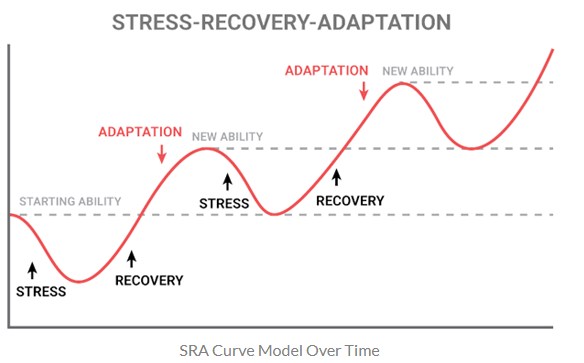
So that’s why if the volume (the total # of sets and reps) and intensity (load) is high enough, training 3x/week is aplenty.
Alternatively, you could purposely perform shorter, less intense workouts (lower to mid volume and intensity) but do these workouts nearly daily since you have less to recover from.
Benefits of training at a high frequency:
- It’s really good at building the habit.
- You get more practice with exercises to faster clean up your form and build confidence.
- It also toughens you up, reduces the excuses and you’ll be more in-tune with understanding your body.
- If you’re aiming for 5x/week and you happen to miss a day, it’s not detrimental if you happen to miss a workout and only get 4 days. (Versus if you workout 3x/week and you miss a day and now you only got 2 workout days in.)
One major issue with working out 6 days a week is that it could take more of your time overall if a thorough warm-up and then shower afterwards (the annoying book-ends of a workout session) are necessary. But not everybody needs to warm-up thoroughly or shower immediately afterwards, so it’s a very personal decision one needs to make when choosing how frequently they could workout and have it be sustainable (practical) in the long run.
If time is not an issue, you genuinely look forward to moving your body daily and it’s very helpful for you to do a habit nearly daily, then that higher workout frequency is going to be more ideal for you. You just need to not workout as hard each day on purpose so you have gas left in the tank. This is also a bit more difficult to fine-tune but something like my minimal routine has laid out a plan for you to do exactly that. It works because it only requires you to focus on 2 exercises, you don’t need to do the workout all in one continuous session (you could break it up throughout the day), you don’t need a warm-up and don’t do enough volume to sweat or need to shower afterwards and the rep scheme allows you to workout almost daily.
But… and this is a big but: Most people don’t have all the time in the world (nor the motivation to do the same thing every single day without it feeling monotonous), so allotting time in their schedule to workout just 3x/week might fit better. Only you know what’s best for you and hopefully with this information you are now empowered to better structure and optimize your own routines!
To put it succinctly: The best frequency, intensity and volume is the one that allows you to train consistently in a sustainable manner.
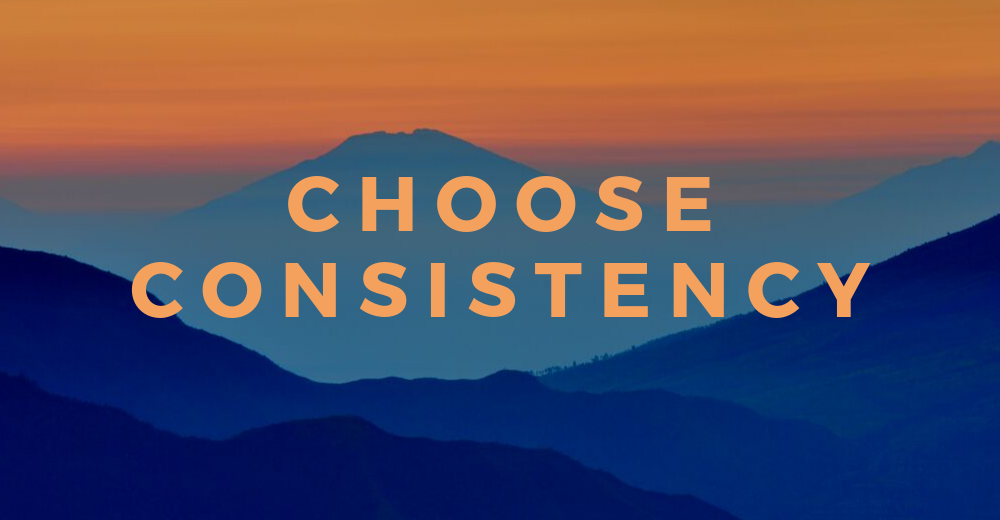
- For strength training, start with compound exercises and finish with isolation / accessory exercises.
- For flexibility training, stretch the individual muscles first before moving to the grand-daddy pose.
- Treat flexibility training in the same methodical fashion as strength training: Stretch with sets and reps (or hold times) rather than just by feel.
- Both strength and flexibility require a minimum of 3 minutes of time under tension per muscle group to make lasting change.
- You must strike a balance between volume, intensity and frequency.
- The same way you don’t have to strength-train everyday, flexibility is no different: you don’t have to stretch everyday.
- You could choose to have shorter (low to medium intensity and volume) but more frequent sessions (5-6x/week). Or longer sessions (medium to high intensity and volume) but less frequent sessions (2-3x/week).
Now that you have the outline and tools to understand what makes an effective workout session both for strength and flexibility, you now know that there are several valid ways of working out. All roads lead to Rome if structured properly. The most important decision factor is the one that allows you to workout consistently. If a workout is created by an Olympic coach and it’s supposed to be the best, but it’s not sustainable for your schedule, then it’s not really the “best” for you. Through practice and experience, you’ll figure out what works best for you with your current lifestyle.
Strength Training Focused Programs
| Program | Frequency | Info | |
| Free | Bodyweight Training | 1-2hrs, 3-6x/week | Push/Pull Split |
| Free | Minimal Routine | 30mins, 5x/week | Focused on simplicity, good for basic strength |
| Premium | Rings Routine | 1-2hrs, 3x/week | Most popular, excellent for beginners to intermediates |
| Premium | Hypertrophy Focused | 1-2hrs, 3x/week | good for intermediate to advanced |
| Premium | Quick & Effective Program | 30mins, 4x/week | Short, frequent workouts |
| Premium | Work From Home | 15-30mins, 3-5x/week | Short, frequent workouts with follow along videos |
| Premium | Smart Core | 4-7min, 3x/week | Just for abs and glutes! |
Flexibility Programs with Follow Along Yoga-Style Videos
| Program | Frequency | Info | |
| Premium | Hamstring Flexibility | 30mins, 3x/week | Improve hamstring flexibility efficiently. |
| Premium | Hip Flexibility | 30mins, 3x/week | Improve lower body flexibility with major focus on the hips. |
| Premium | Shoulder & Upper Back Flexibility | 30mins, 3x/week | Improve posture, shoulder mobility and thoracic extension. |
Flexibility Programs, laid out methodically with Sets and Timers
| Program | Frequency | Info | |
| Free | Toe Touching Routine | 30mins, 3x/week | Goal is to touch your toes with straight legs. |
| Free | Splits Routine | 30mins, 3x/week | Improve your front, middle and pancake splits. |
| Free | 7 minute Flexibility | 4-7mins, Daily | Full body flexibility/loosening up daily. |
| Premium | Front Splits Fast | 30mins, 3x/week | Focus on achieving the front splits. |






